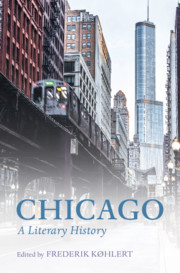16 results
Figures
-
- Book:
- Chicago
- Published online:
- 02 September 2021
- Print publication:
- 23 September 2021, pp ix-ix
-
- Chapter
- Export citation
Chapter 26 - Drawing Chicago: Chris Ware’s Graphic City
- from Part V - Traditions and Futures: Contemporary Chicago Literatures
-
-
- Book:
- Chicago
- Published online:
- 02 September 2021
- Print publication:
- 23 September 2021, pp 370-386
-
- Chapter
- Export citation
Part III - Radicalism, Modernism, and the Chicago Renaissance
-
- Book:
- Chicago
- Published online:
- 02 September 2021
- Print publication:
- 23 September 2021, pp 151-236
-
- Chapter
- Export citation
Part IV - A City of Neighborhoods: The Great Depression, Sociology, and the Black Chicago Renaissance
-
- Book:
- Chicago
- Published online:
- 02 September 2021
- Print publication:
- 23 September 2021, pp 237-324
-
- Chapter
- Export citation
Contents
-
- Book:
- Chicago
- Published online:
- 02 September 2021
- Print publication:
- 23 September 2021, pp v-viii
-
- Chapter
- Export citation
Index
-
- Book:
- Chicago
- Published online:
- 02 September 2021
- Print publication:
- 23 September 2021, pp 462-492
-
- Chapter
- Export citation
Selected Bibliography
-
- Book:
- Chicago
- Published online:
- 02 September 2021
- Print publication:
- 23 September 2021, pp 441-461
-
- Chapter
- Export citation
Part I - The Rise of Chicago and the Literary West
-
- Book:
- Chicago
- Published online:
- 02 September 2021
- Print publication:
- 23 September 2021, pp 15-80
-
- Chapter
- Export citation
Introduction: The Literary History of Chicago
-
-
- Book:
- Chicago
- Published online:
- 02 September 2021
- Print publication:
- 23 September 2021, pp 1-14
-
- Chapter
- Export citation
Part V - Traditions and Futures: Contemporary Chicago Literatures
-
- Book:
- Chicago
- Published online:
- 02 September 2021
- Print publication:
- 23 September 2021, pp 325-440
-
- Chapter
- Export citation
Copyright page
-
- Book:
- Chicago
- Published online:
- 02 September 2021
- Print publication:
- 23 September 2021, pp iv-iv
-
- Chapter
- Export citation
Part II - Business Unusual: A New Urban American Literature
-
- Book:
- Chicago
- Published online:
- 02 September 2021
- Print publication:
- 23 September 2021, pp 81-150
-
- Chapter
- Export citation
Contributors
-
- Book:
- Chicago
- Published online:
- 02 September 2021
- Print publication:
- 23 September 2021, pp x-xv
-
- Chapter
- Export citation
Acknowledgments
-
- Book:
- Chicago
- Published online:
- 02 September 2021
- Print publication:
- 23 September 2021, pp xvi-xvi
-
- Chapter
- Export citation

Chicago
- A Literary History
-
- Published online:
- 02 September 2021
- Print publication:
- 23 September 2021
Andrew J. Kunka, Autobiographical Comics (London: Bloomsbury, 2018, £21.99). Pp. 290. isbn978 1 4742 2784 1.
-
- Journal:
- Journal of American Studies / Volume 53 / Issue 4 / November 2019
- Published online by Cambridge University Press:
- 05 November 2019, E64
- Print publication:
- November 2019
-
- Article
- Export citation

